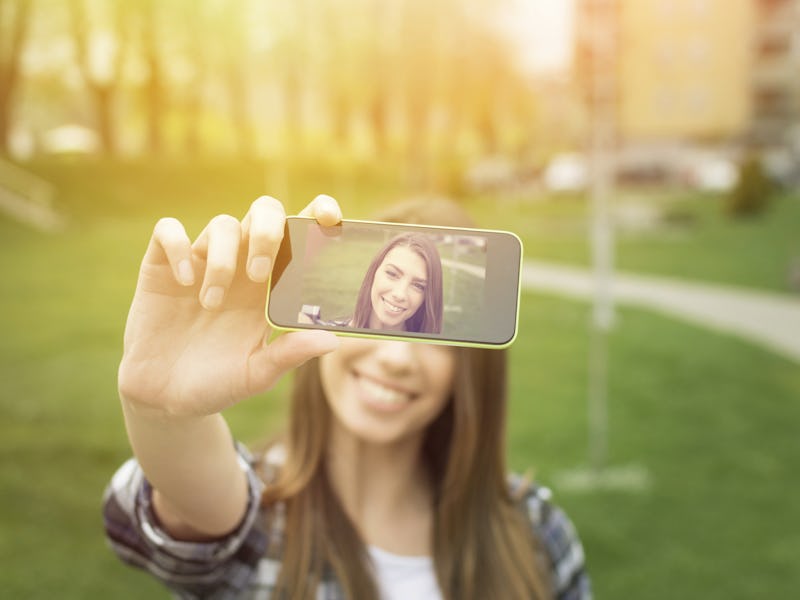Pay With a Selfie: Why Google, Amazon, and MasterCard Want Us to Do It
And Apple's next.

Sometimes big companies make big decisions for us. As MasterCard and Amazon will both be incorporating further biometrics into their verification and payment systems, and as Google rolls out its Hands Free program, Apple is rumored to be keeping pace. Those further biometrics include, but are not limited to, eye- and facial-recognition capabilities — which, in effect, means you’ll need to get used to posing for selfies.
Here’s how it might look:
Buying a new pair of shoelaces on Amazon! ~ selfie ~
Paying for my coffee and croissant! ~ smile ~
About to dig into this meaty Big Mac! ~ wink ~
It’s somewhat ludicrous to imagine. Consider, say, a line in a taco place. Ten wait in line to pay; the “cashier,” who’s no longer actually a cashier, asks the next customer to step forward. Instead of pulling out his or her wallet to grab cash or a card, said customer merely stares into a camera, blinking or winking once or twice to truly verify his or her identity, and then calmly retires to a corner to await three subpar tacos.
And yet — this may indeed be a future we’ll soon behold, ludicrous though it now may seem. Google’s Hands Free system operates on the assumption that people hate digging around for cash, pulling out and swiping cards, pressing extraneous buttons, and signing receipts. Watch:
Hands Free will not make you take selfies, but it will employ facial recognition. In one instantiation, your mobile device communicates with the participating store’s (now-defunct) cash register. After completing your order, you merely say “I’ll pay with Google.” The “cashier” then sees your Hands Free profile picture and verifies that it’s really you — and that’s it. In the other instantiation, the vendor will have a facial recognition camera and system that scans your face, compares it with your profile picture’s biometrics, then verifies your identity. (This tech is now live in — where else — select parts of San Francisco. At the moment, you can only use it at participating McDonald’s and Papa John’s stores.)
As for Apple, rumors abound. Ming-Chi Kuo, a KGI Securities researcher renowned as an Apple prophet, says that the iPhone 7 will be able to recognize you in all your glory.
These rumors gain some traction, albeit limited tracking, with Apple’s latest intellectual property acquisitions. Earlier this year, Apple acquired a facial- and emotion-recognition start-up called Emotient.
An Apple spokeswoman told the Wall Street Journal that Apple had indeed purchased the company, but, true to form, declined to explain the end goals. Apple also acquired Faceshift, which also learns your face’s particulars.
But Faceshift seems more playful than practical: it seems to use your own, real-time expressions to modify an avatar’s expressions. (Like so.) The more likely explanation for this latter acquisition is more jocular group video chats, but this biometric company acquisition by Apple is one of many.
So, even if Apple’s primary goals with facial recognition are not to make you pay for things with your face, the technology will be there. iPhones can already detect faces, and the native Apple app Photos can, with some training, recognize faces. And Apple Pay’s already got the requisite ad campaigns underway: The safer way to pay. With your fingerprint. A simple change makes that read: The safer way to pay. With a selfie.
And, against all rational skepticism, selfie payments may indeed be more secure. There are various and complex authentication steps to such facial recognition systems, which is not the case with dupable fingerprint scanners. Companies like MasterCard are more interested in the technology to supplement existing verification checks. (If there were any doubt about your identity after your credit card information, password, and fingerprint, you can smile for the selfie camera, too.)
Alternatively, you can take a somber selfie and wonder into what odd universe you've fallen.
Not only that, but some people enjoy biometric verification. (At least if we’re to believe a self-serving MasterCard press release entitled, sans humor, “Dutch People Prefer Biometric Payments.”)
Whether the general population can get down with selfie payments is as yet unclear, though. Fingerprint scans are easy enough, though at times unreliable. Those among us who revile selfies will silently suffer as the next generation of identity verification enshrouds the last. Those peculiar few who love selfies will rejoice: all the more reason to pose for your own camera.